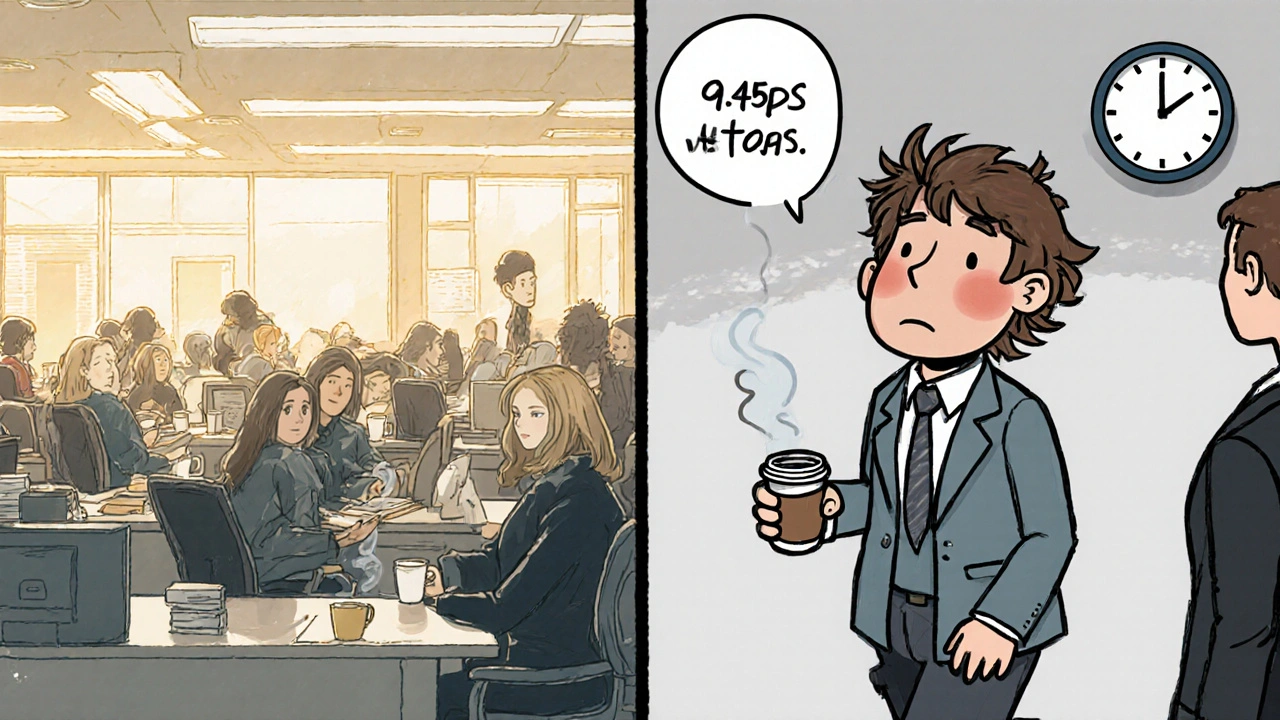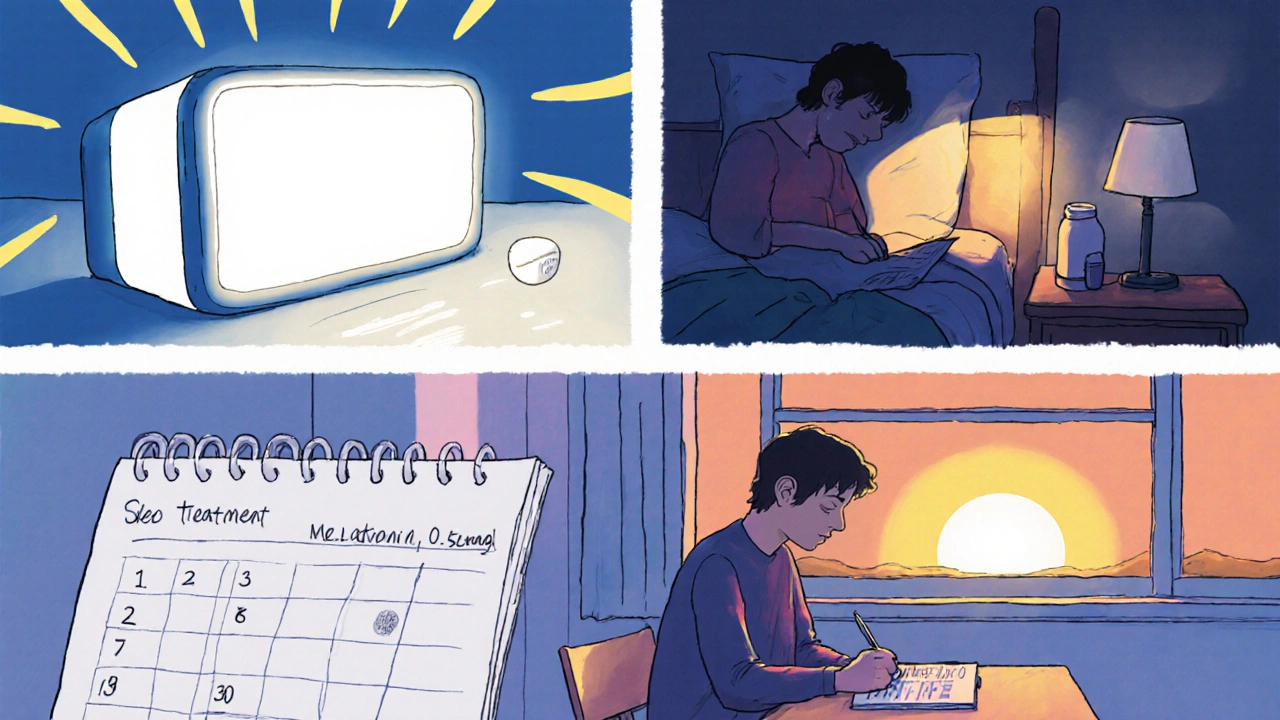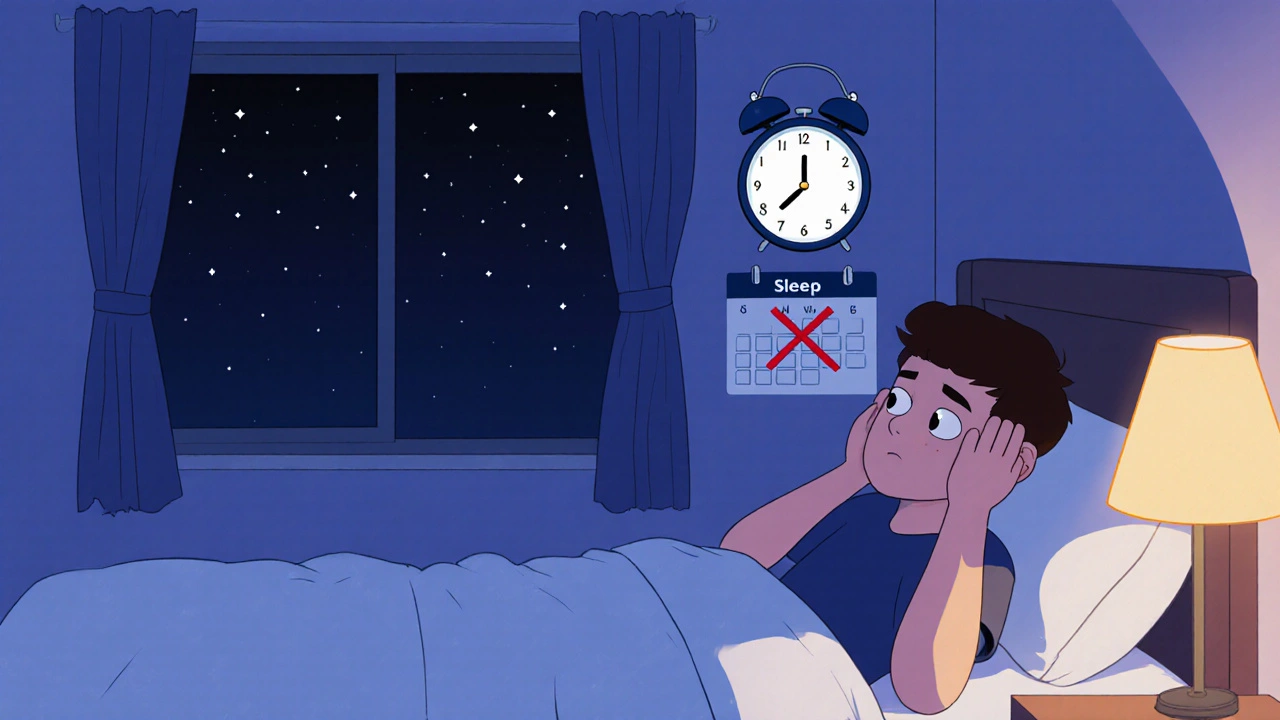DSPS Sleep Schedule Calculator
Calculate Your Ideal Sleep Schedule
This tool helps you determine the best bedtime for your desired wake time, based on the principles of circadian rhythm adjustment for DSPS.
Your Sleep Schedule
Adjustment Recommendation
-
Optimal Timing for Therapy
Delayed Sleep Phase Syndrome is a circadian rhythm sleep‑wake disorder where the internal body clock is shifted later than the societal norm, causing difficulty falling asleep until the early morning hours and trouble waking up at a conventional time. People with this condition often find their daily routines, work performance, and relationships strained. In this guide we’ll explore the ways the disorder seeps into every corner of life and list concrete steps you can take to regain control.
Quick Takeaways
- DSPS pushes sleep onset to 2‑5 am on average, making typical 9‑5 jobs nearly impossible.
- Consequences include daytime sleepiness, reduced academic or work performance, mood disorders, and higher accident risk.
- Effective treatments combine timed bright‑light exposure, low‑dose melatonin, and gradual sleep‑schedule adjustments.
- Lifestyle tweaks-consistent bedtime routines, strategic napping, and workplace accommodations-can dramatically lift quality of life.
Understanding the Disorder
At its core, Circadian Rhythm Disorder is a mismatch between the internal biological clock and external cues like light and social schedules. Chronotype describes an individual’s natural preference for mornings or evenings; DSPS represents an extreme evening chronotype.
The condition is diagnosed when a person’s sleep‑wake timing is delayed by at least two hours relative to conventional times, and the pattern persists for three months or longer. Unlike occasional “night‑owl” behavior, DSPS is stable and often has a genetic component involving the PER3 gene.
How DSPS Disrupts Daily Life
When your body insists on staying up until 4 am, the world is already awake. That mismatch shows up in three major arenas:
- Work and School: Arriving late, missing morning meetings, and needing to rely on caffeine or naps. Studies from the University of Toronto show that employees with DSPS report 23 % lower self‑rated productivity.
- Social Relationships: Evening‑focused friends or partners may feel ignored. Dating can become awkward when one person prefers brunch while the other is barely functional before noon.
- Mental Health: Chronic misalignment is linked to higher rates of depression and anxiety. A 2022 cohort of 1,200 adults found a 1.8‑fold increase in depressive symptoms among those meeting DSPS criteria.
These pressures create a feedback loop: poor sleep worsens mood, which in turn deepens the sleep difficulty.
Physical Health Consequences
Beyond the obvious fatigue, delayed sleep timing can affect bodily systems:
- Metabolism: Late-night eating often coincides with lower insulin sensitivity, raising risk for obesity and type‑2 diabetes.
- Immune Function: Disrupted sleep reduces natural killer cell activity, making sufferers marginally more prone to colds.
- Accident Risk: Daytime sleepiness contributes to motor‑vehicle crashes; the National Highway Traffic Safety Administration reports a 12 % increase in crash odds for drivers who schedule sleep after 2 am.

Mental Health and Cognitive Effects
Sleep is the brain’s housekeeping time. When DSDS (Delated Sleep Phase Syndrome) forces the brain to work against its clock, you see:
- Decreased attention span and slower reaction times.
- Impaired memory consolidation-students often struggle to retain lecture material.
- Heightened emotional reactivity; minor setbacks feel magnified.
In a controlled trial, participants receiving light‑therapy and melatonin showed a 30 % reduction in Beck Depression Inventory scores after eight weeks, underscoring the treatable nature of these symptoms.
Social and Economic Costs
From a macro perspective, DSPS translates into tangible costs:
- Lost work hours: The Canadian Centre for Occupational Health estimates that 1 % of the workforce with DSPS loses roughly 4 hours per week, amounting to $1.3 billion annually.
- Healthcare utilization: Individuals with untreated DSPS visit primary‑care physicians 15 % more often for fatigue‑related complaints.
- Educational setbacks: College students report a 0.4 GPA penalty on average when their class schedule conflicts with their natural sleep timing.
These figures highlight why early diagnosis and management matter not just for the individual, but for society.
Managing DSPS - What Works?
There is no one‑size‑fits‑all cure, but a combination of chronobiology‑based strategies yields the best outcomes.
1. Bright‑Light Therapy
Exposing yourself to 10,000 lux of cool‑white light within an hour of waking helps shift the circadian phase earlier. Consistency matters-use a light box for 20‑30 minutes daily, preferably at the same time.
2. Melatonin Supplementation
Low‑dose (0.3‑0.5 mg) melatonin taken 5 hours before your desired bedtime can advance sleep onset. Timing is critical; taking it too early may delay the clock further.
3. Chronotherapy (Gradual Shift)
Shift your bedtime earlier by 15 minutes each night until you reach the target time. This method requires strict adherence and should be supervised by a sleep specialist.
4. Cognitive‑Behavioral Therapy for Insomnia (CBT‑I)
CBT‑I addresses maladaptive thoughts about sleep, helps establish a calming pre‑sleep routine, and reduces reliance on stimulants.
5. Lifestyle Tweaks
- Avoid screens at least one hour before intended sleep; blue‑light filters can help.
- Limit caffeine after noon.
- Schedule exercise in the morning rather than late evening.
- Keep bedroom temperature between 16‑19 °C for optimal sleep efficiency.

Practical Tips to Boost Quality of Life
Even if you can’t fully reset your rhythm, the following actions can make daily life smoother:
- Communicate with Employers or Teachers: Request flexible start times or remote work options during the adjustment phase.
- Plan Important Activities for Later in the Day: Schedule meetings, workouts, and social events after 11 am when you’re naturally more alert.
- Use Strategic Naps: A 20‑minute nap around 2 pm can alleviate sleep pressure without disrupting nighttime sleep.
- Track Sleep with a Journal or App: Monitoring patterns helps you spot triggers and measure progress.
- Seek Professional Guidance: Sleep clinics can conduct a dim‑light melatonin onset (DLMO) test to personalize treatment timing.
Implementing just a few of these habits often yields noticeable improvements in mood, energy, and overall wellbeing.
Comparison of Common Circadian Rhythm Disorders
| Disorder | Typical Sleep Onset | Typical Wake Time | Common Impacts | First‑Line Treatment |
|---|---|---|---|---|
| Delayed Sleep Phase Syndrome | 02:00‑05:00 am | 10:00‑13:00 pm | Daytime sleepiness, missed work, mood swings | Morning bright‑light, evening melatonin |
| Advanced Sleep Phase Syndrome | 18:00‑20:00 pm | 02:00‑04:00 am | Early morning awakening, insomnia | Evening bright‑light, timed melatonin |
| Non‑24‑Hour Sleep‑Wake Rhythm Disorder | Rotates later each day | Shifts continuously | Unpredictable sleep, severe impairment | High‑dose melatonin, zeitgebers, sometimes tasimelteon |
Frequently Asked Questions
Can adults develop DSPS, or is it only a teenage problem?
Yes, adults can develop or continue to experience DSPS. While many notice the pattern during adolescence, it often persists into adulthood or emerges later due to shift‑work, travel, or lifestyle changes.
Is melatonin safe for long‑term use?
Low‑dose melatonin (0.3‑1 mg) taken at the same time each evening is generally considered safe for most adults. High doses or prolonged use should be discussed with a physician, especially if you are pregnant or taking other medications.
Can caffeine help me stay awake during the day?
Caffeine can temporarily boost alertness, but overreliance may worsen nighttime sleep and create a vicious cycle. Limit intake to early morning and avoid it after 10 am for best results.
Do I need a sleep study to confirm DSPS?
A formal polysomnography isn’t usually required. A detailed sleep diary combined with actigraphy (a wrist‑worn motion sensor) often provides sufficient evidence. In complex cases, a sleep clinic can perform a dim‑light melatonin onset test.
Is there a genetic test for DSPS?
Research links variants in the PER3 and CK1δ genes to delayed sleep timing, but commercial genetic testing is not yet standard practice. Most clinicians rely on clinical assessment rather than DNA results.

Ben Bathgate
October 19, 2025 AT 14:30Man, this guide sounds like a corporate brochure trying to sell a light‑box. If you actually need help, start by cutting the caffeine, not by sprinkling buzzwords about PER3 genes.
Christian Georg
October 24, 2025 AT 05:37Hey folks 😊, great rundown! The bright‑light tip works best if you combine it with a consistent wind‑down ritual-think dim lights, a warm shower, and maybe some light reading. Also, tracking your sleep on an app can reveal hidden patterns, so you can fine‑tune the melatonin timing.
Christopher Burczyk
October 28, 2025 AT 19:44From a clinical perspective, the diagnostic criteria you listed align with the International Classification of Sleep Disorders (ICSD‑3). It is crucial to differentiate DSPS from simple delayed sleep habits by confirming a stable phase delay of at least two hours for a minimum of three months, preferably corroborated by actigraphy.
Jay Kay
November 2, 2025 AT 10:50Wow, another list of “simple tricks” that sound like they belong in a high‑school health class. You can’t just tell people to “avoid screens” when most of us need them for work. The real issue is that society forces a 9‑5 schedule on night‑owls, and that’s the biggest drama.
Jameson The Owl
November 7, 2025 AT 01:57What they don’t tell you is that the light‑box industry is funded by the same shadowy groups that push an artificial 24‑hour economy on us. The real solution is to reject the imposed schedule and return to natural sunrise cycles, which the elites hide because it would undermine their control over productivity metrics.
Rakhi Kasana
November 11, 2025 AT 17:04Honestly, the guide misses the emotional toll-those sleepless nights can erode relationships. A balanced approach that includes therapy for anxiety, alongside the bright‑light and melatonin regimen, is far more humane than a one‑size‑fits‑all checklist.
Sarah Unrath
November 16, 2025 AT 08:10i think you need to be more specific about the timing of melatonin its not just any time you take it it has to be before bedtime otherwise it might make things worse
James Dean
November 20, 2025 AT 23:17While the drama around DSPS can feel intense, remember that our bodies are adaptable. If you treat sleep like a conversation rather than a command, you’ll gradually find a rhythm that honors both your biology and your commitments.
Catherine Viola
November 25, 2025 AT 14:24In light of the aforementioned considerations, it is incumbent upon us to scrutinize the purported neutrality of the presented data. One must inquire whether the cited studies have undergone rigorous peer‑review, lest we propagate conclusions that may inadvertently serve undisclosed commercial interests.
sravya rudraraju
November 30, 2025 AT 05:30Dear community, let us embrace a proactive stance toward DSPS by integrating the strategies outlined herein with a compassionate mindset. Consistency in exposure to morning light can recalibrate circadian timing, yet it should be complemented by mindful nutrition-avoiding heavy meals after 7 p.m. can prevent metabolic disruptions that exacerbate insomnia. Additionally, scheduling brief, purposeful breaks throughout the day can mitigate stress, a known precipitant of sleep disturbances. Engage your support network; sharing your schedule adjustments with family or colleagues fosters understanding and facilitates flexible accommodations. Finally, celebrate incremental victories-each earlier awakening is a triumph over the relentless pull of delayed sleep phases.
Ankitpgujjar Poswal
December 4, 2025 AT 20:37Listen up, the best way to fight DSPS is to hit the ground running-literally. Get up with the sun, blast that light box, and smash a quick workout before you even think about coffee. No excuses.
Bobby Marie
December 9, 2025 AT 11:44DSPS is real.
Caroline Keller
December 14, 2025 AT 02:50Everyone who reads this article is clearly living life on autopilot, ignoring the deeper moral crisis of a society that forces us into unhealthy sleep patterns. It's just another symptom of how we prioritize profit over human well‑being, and that's unacceptable.
dennis turcios
December 18, 2025 AT 17:57While the guide attempts to be comprehensive, it glosses over the fact that many of these interventions lack robust longitudinal data. A critical reader should demand more than anecdotal success rates before adopting such protocols.